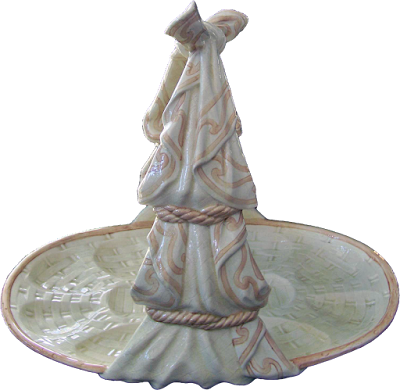One topic that comes up repeatedly on people's want-to-know list concerning majolica are the marks used by various potters to mark their wares. Those companies that marked their wares, and many of them did, were erratic in sometimes marking pieces and sometimes not marking pieces. This shouldn't come as a surprise when you consider that the production period for many of these wares often covered between 50 to 100 years. Even small potteries like the Phoenix Pottery that operated over a much shorter period of time were erratic. One company though, that was quite fastidious about marking their wares is the inventor of the majolica process, Minton.
Although Minton had been marking their wares since 1805, it wasn't until 1842 that Minton introduced on their earthenwares the series of date code marks that are we are familiar with on majolica today.
Beginning in 1851, around the same time as the introduction of the majolica process, Minton supplemented this mark by using the word MINTON or, after 1873, MINTONS in capital letters. In addition to these Minton often used three other impressed marks: a letter indicating the month of manufacture, a pattern shape number, and a potter's mark, though not all pieces will display all three.
Above is example of a typical Minton mark. If we check the chart above, the cypher impressed into the body indicates this piece was made in 1881. The impressed S tells us it was potted in September. If the English registration mark to the left were legible it would also give us the day of registration as well.
Minton majolica marks are always impressed into the body and always found on the base or underside of the piece. Occasionally a thick glaze will obliterate part of the mark so it may not be seen but it is almost always there. On large pieces the mark can be found on the foot or sometimes even the inside of the piece but considering the consistency the company had in marking its majolica almost all pieces are marked.
The method of marking proved so successful that some smaller companies adapted the use of these date code marks for their own pieces. To guarantee that a piece was made by Minton and not another company it is best to look for the impressed MINTON mark in addition to the date code when trying to determine the pedigree of any particular piece.
Although Minton had been marking their wares since 1805, it wasn't until 1842 that Minton introduced on their earthenwares the series of date code marks that are we are familiar with on majolica today.
Above is example of a typical Minton mark. If we check the chart above, the cypher impressed into the body indicates this piece was made in 1881. The impressed S tells us it was potted in September. If the English registration mark to the left were legible it would also give us the day of registration as well.
Minton majolica marks are always impressed into the body and always found on the base or underside of the piece. Occasionally a thick glaze will obliterate part of the mark so it may not be seen but it is almost always there. On large pieces the mark can be found on the foot or sometimes even the inside of the piece but considering the consistency the company had in marking its majolica almost all pieces are marked.
The method of marking proved so successful that some smaller companies adapted the use of these date code marks for their own pieces. To guarantee that a piece was made by Minton and not another company it is best to look for the impressed MINTON mark in addition to the date code when trying to determine the pedigree of any particular piece.




































